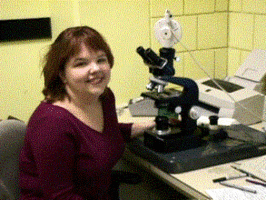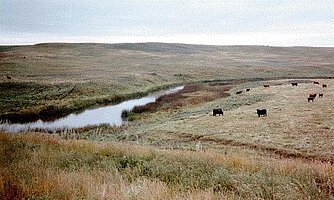The Periphyton in the Sheyenne River, North Dakota

Megan A. Jaskowiak, originally from Bethel, Ohio, received a B.A. from Northern Kentucky University in 1997. She became interested in algae specifically the diatoms while doing an independent study project with her advisor, Dr. Miriam Kannan. In 1995, she studied “Ecology and Systematics of Diatoms” with a prominent diatomist, Dr. E. Stoermer at Lakeside Laboratory in Iowa. Megan is working on her Ph.D. in Botany at North Dakota State University, with completion anticipated in 2002. She looks forward to a career which involves both teaching and research.
Fellow: Megan A. Jaskowiak,Department of Botany, NDSU
Advisor: Marvin W. Fawley, Professor of Biology, NDSU
Matching Support: North Dakota State Department of Health, Bismarck; NDSU central administration
Degree Progress: Ph.D. completion anticipated in 2002.
The Periphyton in the Sheyenne River, North Dakota
Devils Lake in Northeastern North Dakota is presently a closed basin, but rising, lake. Its size has been increasing for more than a decade, and if the rise continues there will be an uncontrolled flow into the Sheyenne River at some time in the future. An engineered outlet is being considered in order to provide a more controlled flow and reduce physical damage and water quality degradation that would come from an uncontrolled flow.
This research began as part of the environmental impact statement for the Army Corps of Engineers Devils Lake outlet project. In the first part of this study, periphytic aglae were collected using artificial substrates at several sites along the Sheyenne River. The major goal of this study was to relate the periphyton communities to environmental factors that could potentially be affected by a Devils Lake outlet.
The relative abundance data for species of periphytic algae and environmental data were used for the assessment. This analysis was completed using canonical correspondence analysis (CCA). The environmental variables which explained the most variance in the periphyton communities were pH, orthophosphate, hardness, arsenic, sulfate and nitrite+nitrate. This analysis included all species identified. An analysis was repeated after the species which are considered to be phytoplanktonic were removed. This evaluation showed different environmental variables which explained the most variance. These environmental variables were percent sodium, calcium, pH, arsenic, and sulfate. This analysis proved to be more statistically significant. The phytoplankton species are not really part of the periphyton community and therefore, the variation seen in these species is coincidental. Therefore, the removal of these species makes the analysis more precise. These results were presented in a poster presentation at the 2000 North American Benthological Society meeting in Keystone, CO, and as a report to the Corps of Engineers.
The research that has been completed also includes a comparision of the natural substrates and artificial substrates and a comparison of the use of presence/absence data versus relative abundance data in CCA. Natural substrate communities appear to be quite different than the artificial substrate communities. These differences include several species which were not found at all on the artificial substrates. An example of these additional species is the diatom, Navicula mutica. The statistical analysis of the presence/absence and natural versus artifical substrates will be completed in the summer 2001.
Research that will also be completed this year includes the examination of three new possible species of Nitzschia (Hassall). The preliminary results from the new species will be presented at the Phycological Society Meeting in June 2001. The survey of the periphyton in the Sheyenne River is being prepared for publication. The results from studies completed in 2000-2001 will be prepared for publication.
Publications
Phillips, K. A., Jaskowiak, M. A. and M. W. Fawley. 2000. An Analysis of the algal communities of the Sheyenne River, North Dakota, potentially affected by the Devils Lake emergency outlet. A report submitted to the U. S. Army Corps of Engineers.
Presentations
Jaskowiak, M. A., Phillips, K. A. and M. W. Fawley. 2001. Three possible new species of Nitzschia Hassall (Bacillariophyta) from the Sheyenne River, ND. Poster presentation at the Phycological Society of America Meeting in Estes Park, CO.
Jaskowiak, M. A., Phillips, K. A. and M. W. Fawley. 2000. An investigation using canonical correspondence analysis (CCA)of the environmental variables that shape the periphytic communities in the Sheyenne River, ND. A poster presentation at the North American Benthological Society Meeting, Keystone, CO.
Jaskowiak, M. A., Phillips, K. A. and M. W. Fawley. 1999. The periphytic algae in the Sheyenne River, ND, Preliminary Results. A poster presentation at the North American Benthological Society Meeting, Duluth, MN.
Relevant Publications of M. A. Jaskowiak and the Fawley Research Group
Reports and Book Chapters
Fawley, M. W., K.A. Phillips and M. A. Jaskowiak, An Analysis of the algal communities of the Sheyenne River, North Dakota, potentially affected by the Devils Lake emergency outlet, report submitted to the U. S. Army Corps. of Engineers, 2000. [Available from: Dr. M.W. Fawley, Department of Biology, NDSU, Fargo, ND 58105]


Marvin W. Fawley
Botnany, NDSU


